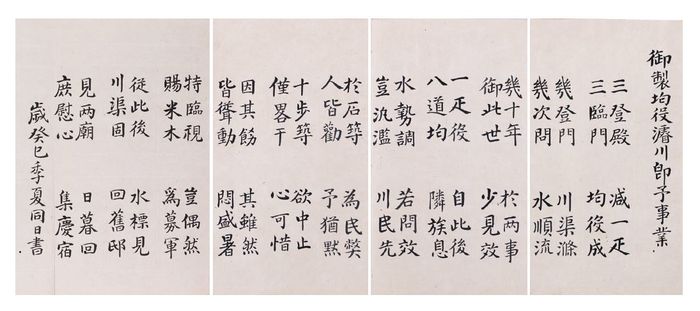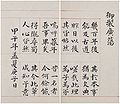"(Translation) 御製均役濬川卽予事業"의 두 판 사이의 차이
Jaeyoon.song (토론 | 기여) |
|||
| 94번째 줄: | 94번째 줄: | ||
# Why did Yŏngjo compose this text in three-character verse form? | # Why did Yŏngjo compose this text in three-character verse form? | ||
# Why do you think it was necessary to resume the project? | # Why do you think it was necessary to resume the project? | ||
| + | <!-- | ||
| + | =='''Further Readings'''== | ||
| − | |||
| − | |||
<div style="color:#008080;"> | <div style="color:#008080;"> | ||
* View together with '''[[Record of Property Distribution among Brothers from 1621]]'''. | * View together with '''[[Record of Property Distribution among Brothers from 1621]]'''. | ||
</div> | </div> | ||
| − | + | ||
* | * | ||
* | * | ||
| 191번째 줄: | 191번째 줄: | ||
==='''Student 14 : (Write your name)'''=== | ==='''Student 14 : (Write your name)'''=== | ||
---- | ---- | ||
| − | + | --> | |
*Discussion Questions: | *Discussion Questions: | ||
2022년 2월 14일 (월) 23:46 판
| Primary Source | ||
|---|---|---|
 |
Title | |
| English | ||
| Chinese | 御製均役濬川卽予事業 | |
| Korean(RR) | 어제균역준천즉여사업(Eoje gyunyeokjuncheonjeugyeosaeop) | |
| Text Details | ||
| Genre | Royal Documents | |
| Type | ||
| Author(s) | King Yeongjo | |
| Year | 1773 | |
| Source | ||
| Key Concepts | King Yeongjo, | |
| Translation Info | ||
| Translator(s) | Participants of 2017 JSG Summer Hanmun Workshop (Advanced Translation Group) | |
| Editor(s) | ||
| Year | 2017 | |
Introduction
This text was written in the sixth month of 1773 by King Yŏngjo. In this writing, he commemorates his two essential achievements, Equitable Taxation and dredging of the Ch’ŏnggye stream. The Equitable Taxation system, implemented in 1751, reduced tax burden by one bulk of cotton. The dredging of the Ch’ŏnggye stream began in 1760. The construction included dredging the stream, bolstering the banks, and building bridges. Thirteen years later in 1773, King Yŏngjo resumed the project by ordering the construction of stone embankment along the both sides of the Ch’ŏnggye stream. King Yŏngjo himself was deeply engaged in civil engineering projects. In the middle of a hot summer day, he went to inspect the work and console people by distributing rice and wood to them. This valuable text written in three-character verse form evidences how the Ch’ŏnggye stream, one of the symbols of Seoul today, has been managed and transformed since the late 18th century.
Original Script
| Classical Chinese | English |
|---|---|
|
御製均役濬川卽予事業 三等殿 三臨門 減一疋 均役成 幾登門 幾次問 川渠滌 水順流 幾十年 御/於此世 於兩事 少見效 一疋役 八道均 自此後 隣族息 水勢調 豈氾濫 若問效 川民先 於石築 人皆勸 為民獘 予猶默 十步築 僅畧干 欲中止 心可惜 因其飭 皆聳動 其雖然 悶盛暑 特臨視 賜米木 豈偶然 為募軍 徒此後 川渠固 水標見 回舊邸 見兩廟 庶慰心 日暮回 集慶宿 歲癸巳季夏同日書 |
Three times I presided over the court council, three times I approached the gates(1) I eliminated one bulk, and the Equitable Taxation policy was accomplished. Several times I ascended the gate, and several times I inquired into the matters, Waterways and canals were purified, and water flowed smoothly. For several decades I steered this generation/I [worked] for this generation As for these two projects hardly any can see the effect. With one bulk as taxation, all parts of the country are equitable, After this measure, the neighboring tribes came to still. Conditions of the water are adjusted, how could there be overflowing. If somebody asks about the benefits, people living near the waterways will be first [to see it/to be benefited?]. As for the stone embankment, all people urged [to do it]. Because of causing harm to people I remained silent/quiet. With the embankment of ten paces [high], only then was it possible to control [waters]. While wishing to stop the work in the middle, yet in my heart I felt regret, Because of my order, all were excited and elated. Even so, in this suffocating height of summer, I specially came to inspect and bestow rice and wood. Could it be spontaneous to recruit the army for [building it]? Only after this the waterways and canals will be fixed. I observed [the site] from the Sup’yo Bridge and came back to the old residence. I visited two royal gravesites and my mind was relieved.(2) I came back at dusk and stayed in Chipgyŏng Hall(3) Written on the same day of the sixth month of kyesa year (1773) (1) King Yŏngjo went out of his palace to inspect the lives of his people and the ongoing public works. Approaching the gate is a metaphor and a stock phrase for his out-of-palace inspections. (2) These two royal grave sites refer to the tombs of King Yŏngjo’s first son, prince Hyojang, and King Yŏngjo’s grandson, Ŭiso. (3) Chipgyŏng Hall (The Hall of Amassing Blessings) is located in Kyŏnghi Palace, Seoul. |
Discussion Questions
- In the text, King Yŏngjo recorded his visit to his first son and grandson’s grave sites. King Yŏngjo is generally known as a brutal ruler who executed his own son, Crown Prince Sado, by locking him in a rice chest. Does this text show Yŏngjo’s personality in a different light?
- Why did Yŏngjo compose this text in three-character verse form?
- Why do you think it was necessary to resume the project?
- Discussion Questions:




